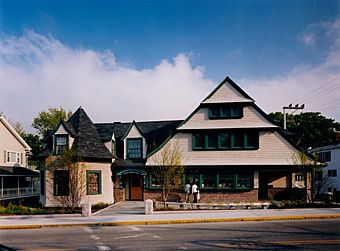Abbe Museum facts for kids
Quick facts for kids |
|
|
Abbe Museum
|
|
 |
|
| Nearest city | Bar Harbor, Maine |
|---|---|
| Area | 0.5 acres (0.20 ha) |
| Built | 1928 |
| Architect | Gilchrist, Edmund B.; Shea Brothers |
| NRHP reference No. | 83000451 |
| Added to NRHP | January 19, 1983 |
The Abbe Museum is a special place with two locations in Bar Harbor, Maine. This town is on Mount Desert Island. The museum teaches visitors about the history and culture of Maine's Native people, called the Wabanaki.
One museum building is in downtown Bar Harbor. The other is at Sieur de Monts inside Acadia National Park. The Sieur de Monts building is very old and has a unique design. It is listed on the National Register of Historic Places. This means it is an important historical building. It was one of the first buildings in Maine made just to be a museum. It also shows a rare style of building called Mediterranean architecture.
The museum has been led by people who want to make museums more fair to Native cultures. In 2020, Chris Newell became the museum's leader. He is a member of the Passamaquoddy tribe. He works closely with the Wabanaki Nations.
Contents
Amazing Collections
The Abbe Museum has many cool items in its collections. These items were made by Native Americans long ago. Some were also made by Europeans who came to the area in the early 1600s.
Ancient Tools and Art
You can see stone tools like arrowheads and spear points. There are also bone tools such as harpoons and hooks. The museum even has bone combs. One very special item is a rare flute made of bone. It might be as old as 2,000 years!
Baskets and Historic Items
The museum also has a large collection of beautiful baskets. These were made by Native artists. Another interesting item is a powder horn. This was used to carry gunpowder. It belonged to Chief Orono of the Penobscot people. The main part of the museum's collection came from a doctor named Robert Abbe. He was a pioneer in using X-rays. He retired to Mount Desert Island because of health problems.
Unique Architecture
The Sieur de Monts building was designed by Edmund M. Gilchrist. It was finished in 1928. This building mixes styles from Spanish Colonial Revival and Italian Renaissance architecture.
Special Design Features
It has a unique eight-sided room. This room was specially designed with Dr. Abbe's ideas to hold his collections. People believe it is the only building in Maine, besides homes, that uses this Mediterranean style. It was also the very first building in the state built specifically to be a museum.
See also
 In Spanish: Museo Abbe para niños
In Spanish: Museo Abbe para niños



